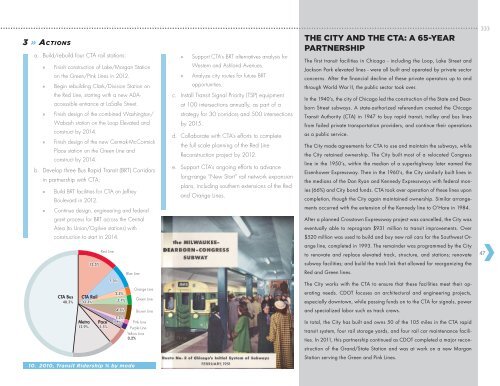Forward - City of Chicago
Forward - City of Chicago
Forward - City of Chicago
You also want an ePaper? Increase the reach of your titles
YUMPU automatically turns print PDFs into web optimized ePapers that Google loves.
3 » Actions<br />
a. Build/rebuild four CTA rail stations:<br />
» Finish construction <strong>of</strong> Lake/Morgan Station<br />
on the Green/Pink Lines in 2012.<br />
» Begin rebuilding Clark/Division Station on<br />
the Red Line, starting with a new ADAaccessible<br />
entrance at LaSalle Street.<br />
» Finish design <strong>of</strong> the combined Washington/<br />
Wabash station on the Loop Elevated and<br />
construct by 2014.<br />
» Finish design <strong>of</strong> the new Cermak-McCormick<br />
Place station on the Green Line and<br />
construct by 2014.<br />
b. Develop three Bus Rapid Transit (BRT) Corridors<br />
in partnership with CTA:<br />
» Build BRT facilities for CTA on Jeffrey<br />
Boulevard in 2012.<br />
» Continue design, engineering and federal<br />
» Support CTA’s BRT alternatives analysis for<br />
Western and Ashland Avenues.<br />
» Analyze city routes for future BRT<br />
opportunities.<br />
c. Install Transit Signal Priority (TSP) equipment<br />
at 100 intersections annually, as part <strong>of</strong> a<br />
strategy for 30 corridors and 500 intersections<br />
by 2015.<br />
d. Collaborate with CTA’s efforts to complete<br />
the full scale planning <strong>of</strong> the Red Line<br />
Reconstruction project by 2012.<br />
e. Support CTA’s ongoing efforts to advance<br />
long-range “New Start” rail network expansion<br />
plans, including southern extensions <strong>of</strong> the Red<br />
and Orange Lines.<br />
THE CITY AND THE CTA: A 65-YEAR<br />
PARTNERSHIP<br />
The first transit facilities in <strong>Chicago</strong> - including the Loop, Lake Street and<br />
Jackson Park elevated lines - were all built and operated by private sector<br />
concerns. After the financial decline <strong>of</strong> these private operators up to and<br />
through World War II, the public sector took over.<br />
In the 1940’s, the city <strong>of</strong> <strong>Chicago</strong> led the construction <strong>of</strong> the State and Dearborn<br />
Street subways. A state-authorized referendum created the <strong>Chicago</strong><br />
Transit Authority (CTA) in 1947 to buy rapid transit, trolley and bus lines<br />
from failed private transportation providers, and continue their operations<br />
as a public service.<br />
The <strong>City</strong> made agreements for CTA to use and maintain the subways, while<br />
the <strong>City</strong> retained ownership. The <strong>City</strong> built most <strong>of</strong> a relocated Congress<br />
line in the 1950’s, within the median <strong>of</strong> a superhighway later named the<br />
Eisenhower Expressway. Then in the 1960’s, the <strong>City</strong> similarly built lines in<br />
the medians <strong>of</strong> the Dan Ryan and Kennedy Expressways with federal monies<br />
(66%) and <strong>City</strong> bond funds. CTA took over operation <strong>of</strong> these lines upon<br />
completion, though the <strong>City</strong> again maintained ownership. Similar arrangements<br />
occurred with the extension <strong>of</strong> the Kennedy line to O’Hare in 1984.<br />
grant process for BRT across the Central<br />
After a planned Crosstown Expressway project was cancelled, the <strong>City</strong> was<br />
Area (to Union/Ogilvie stations) with<br />
eventually able to reprogram $931 million to transit improvements. Over<br />
construction to start in 2014.<br />
$520 million was used to build and buy new rail cars for the Southwest Or-<br />
Red Line<br />
ange line, completed in 1993. The remainder was programmed by the <strong>City</strong><br />
to renovate and replace elevated track, structure, and stations; renovate<br />
47<br />
12.5%<br />
subway facilities; and build the track link that allowed for reorganizing the<br />
Blue Line<br />
Red and Green lines.<br />
CTA Bus<br />
48.3%<br />
CTA Rail<br />
33.3%<br />
7.3%<br />
2.5%<br />
3.1%<br />
Orange Line<br />
Green Line<br />
The <strong>City</strong> works with the CTA to ensure that these facilities meet their operating<br />
needs. CDOT focuses on architectural and engineering projects,<br />
especially downtown, while passing funds on to the CTA for signals, power<br />
4.7%<br />
Brown Line<br />
and specialized labor such as track crews.<br />
Metra<br />
12.9%<br />
Pace<br />
5.5%<br />
1.3%<br />
1.7%<br />
Pink Line<br />
Purple Line<br />
Yellow Line<br />
0.2%<br />
In total, the <strong>City</strong> has built and owns 50 <strong>of</strong> the 105 miles in the CTA rapid<br />
transit system, four rail storage yards, and four rail car maintenance facilities.<br />
In 2011, this partnership continued as CDOT completed a major reconstruction<br />
<strong>of</strong> the Grand/State Station and was at work on a new Morgan<br />
Station serving the Green and Pink Lines.<br />
10. 2010, Transit Ridership % by mode




